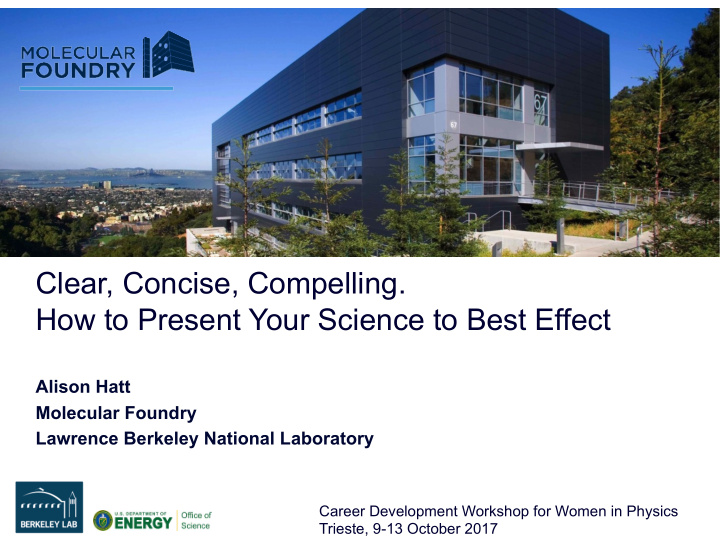



Clear, Concise, Compelling. How to Present Your Science to Best Effect Alison Hatt Molecular Foundry Lawrence Berkeley National Laboratory Career Development Workshop for Women in Physics Trieste, 9-13 October 2017
2
Another approach to camouflaging your ideas using powerpoint overkill…. • important fact buried in a long sentence that you won’t have time to read • Another important fact that I will not refer to in the remainder of the presentation • something that may or may not be important; I haven’t decided yet XMCD • Yet another bullet that I’ve included incase someone asks a question • One more point, t his time inexplicably emphasized in bold font and italics so you know its important Caption for the plot, too small to read but included anyway because my advisor likes captions 2/46 Prestigious University, Institute of Obfuscation 9/5/2010 3
Presen&ng your research is cri&cal for a successful career in science n Seminars n Conferences n Mee&ngs n Job interviews n Disserta&on defense n Teaching n Funding proposals/renewals n Public lectures
There are six steps to create and execute an effec&ve oral presenta&on Plan the presentation Design the presentation Part 1 Make the slides Practice the presentation Deliver the presentation Part 2 (Sinead) Answering questions Doumont, 2009
Planning requires iden&fying your parameters • Who Audience • What • Where Constraints • When • Why Goals Doumont, 2009
Successfully structuring your presentation calls on you to lead your audience up your mountain of work Vista Path Entry Point Alley and Marshall, 2012
An effective presentation must have a clear structure Opening Attention getter Main message Preview Body Point 1 Point 2 Point 3 … Closing Review Conclusion Close
Use slides to support and reinforce your message Opening Body Closing
Most slides suffer from the same problems Too much information Too much text Text hard to read Noisy design Unsuitable images Message not clear
Most slides could be improved by following two simple steps 1) Figure out what the message is 2) Make that message as clear as possible
Conven&onal outline slides are not compelling
An unconven&onal outline slide can be much more engaging
Could this slide be more effec&ve?
This revised slide has a clear message
This revised slide has a clear message
We see some emerging guidelines for making effective slides Limit yourself to one or two points per slide Maximize the signal-to-noise ratio Be redundant with visual, written, and spoken information
Could this slide be more effec&ve? Probes for Single-Molecule Imaging Pros and Cons Ideal properties: small fluorescent quantum upconverting organics proteins dots nanoparticles • brightness ��� ��� ��� ��� • photostability ��� ��� • emission continuity ��� • (lack of) overlap with ��� � � �� cellular autofluorescence • near-IR �� ��� 3
This revised slide has a clear message focus of this talk
An asser&on/evidence slide structure makes the message clear and compelling Assertion The octahedral crystal field splits Fe d states into two bands e g crystal field splitting t 2g Evidence
An asser&on/evidence structure makes the message clear and compelling Understanding charge transport across single-molecule junc&ons required advances in theory new theory old theory Au Counts 0 1 2 0.001 0.01 0.1 1 Benzene-diamine between experimental conductance (G 0 ) Conductance (G 0 ) Au electrodes Su Ying Quek, Steve Louie, Jeff Neaton et al.
An asser&on/evidence structure makes the message clear and compelling Surface effects dominate kinetics in small UCNPs 150nm 50nm 8nm 30nm 100nm Luminescence Lifetime vs UCNP diameter 10 6 W/cm 2 150nm 50nm 30nm 8nm 155 µ s 33 µ s Gargas*, Chan*, Altoe, Cohen Ϯ , Schuck Ϯ et al. Nature Nanotech. 9, 300 (2014) 11
Plots should be designed for maximum clarity 16.7% I MAGING 20.4% N ANOFAB 19.9% 15.2% T HEORY I NORGANIC 9.1% 18.7% B IOLOGICAL O RGANIC
Plots should be designed for maximum clarity data set 2 data set 1 Seshadri, 2010
Microscopy images usually need to be modified As output from microscope Modified for presenta&on Seshadri, 2010
In sec&on one, we have discussed the first three steps for effec&ve presenta&ons n Planning Constraints, goals, message n Designing Beginning, middle, end n Making slides Communicate a message
Resources and References “Preparing figures for publica&on and presenta&ons,” Ram Seshadri, 2010. h_ps://www.mrl.ucsb.edu/~seshadri/PreparingFigures.pdf “Trees, maps, and theorems. Effec&ve communica&on for ra&onal minds.” Jean-luc Doumont. h_p://www.principiae.be/X0300.php “The Crad of Scien&fic Presenta&ons.” Michael Alley h_p://www.cradofscien&ficpresenta&ons.com/ See website for templates and tutorials on the asser&on-evidence approach.
Recommend
More recommend